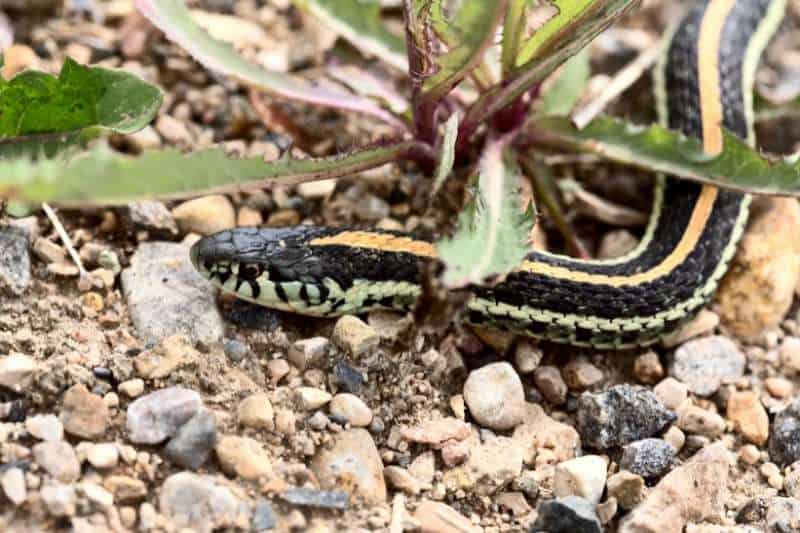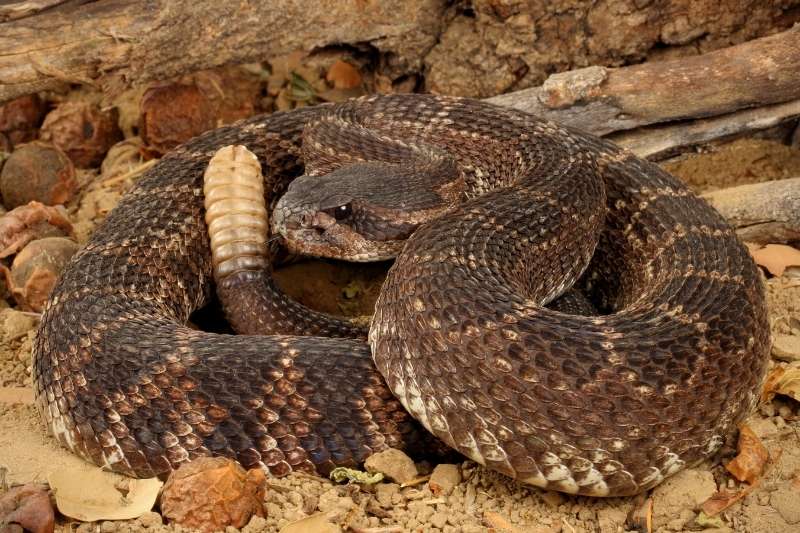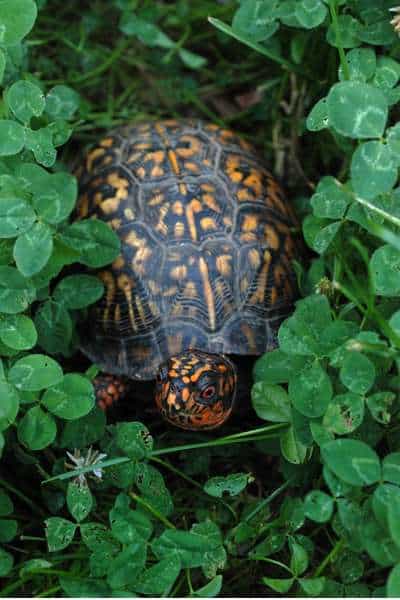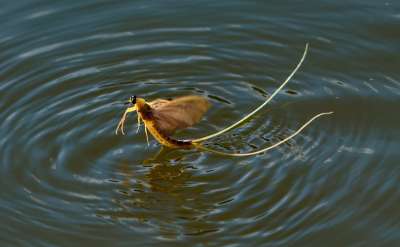Some reptile species give live birth, although most lay eggs. Many snakes give live birth, as do some lizards. Reptiles who give live birth are either “ovoviviparous” or “viviparous”. Ovoviviparous reptiles hatch their eggs inside their bodies; viviparous reptiles nourish their eggs directly.
Reptiles have lived on earth for at least 250 million years. While most modern reptiles lay eggs, the approximately 8,000 species of modern reptiles have had plenty of time to evolve into whatever reproductive method offers them the best chance of long term survival. In the case of many snakes and some lizards, this means bearing live young.
Read on to learn about live birth in reptiles and the advantages and disadvantages of this reproductive strategy.

The three methods of reptilian reproduction
All reptiles reproduce through internal fertilization but evolved three different methods of bringing their embryos to full development: oviparity, ovoviviparity, and viviparity.
Oviparity
Oviparity is the most common method across the reptile group as a whole and means “egg-birth”.
Most modern reptiles enclose their embryos inside hard or leathery shells along with large egg yolks to provide nourishment, then lay those eggs in the environment to finish developing. Oviparous females contribute no nourishment to the embryos after the eggs are created and laid; the embryos are totally dependent on the environment formed by the yolks, extraembryonic membranes, and egg shells for survival.
Ovoviviparity
Ovoviviparity is the second most common method for reptiles and means “egg-live birth”.
Ovoviviparous reptiles produce eggs with large yolks like their oviparous cousins but don’t lay them; they retain the embryos within their oviducts until embryos finish developing.
The yolks still provide the majority of the embryos’ nourishment but the egg membranes also modify and connect directly to the females’ bodies to form a kind of placenta. (Halliday and Adler 1987). These membranes allow the mothers’ bodies to help with the exchange of water, waste products, and respiratory gases as the embryos grow.
When an individual embryo finishes growing, the female expels the live hatchling out of her body and into the world.
Viviparity
Viviparity means “live birth” and is the third and least common reproductive pattern in reptiles, seen mostly in those species that live in colder environments, like those found in high altitudes or at high latitudes (Halliday and Adler 1987).
Viviparous reptiles took the strategy of retaining their embryos and nourishing them internally one step further, making their style of reproduction closer to that of mammals.
Egg yolks are either very small or absent in these species. Instead, the females nourish their embryos directly with resources supplied on an ongoing basis by their own bodies. Viviparous reptiles feed their young through structures similar to placentas in mammals; the embryos receive nutrients, maternal antibodies against infection, and water through a series of blood vessels that connect them to their mothers’ circulatory systems.
Unlike egg-producing reptiles, which provide all the nutrients each embryo needs up front in the form of the egg yolk and nothing more, viviparous females provide their embryos ongoing support at every stage of their development.

What are the advantages of giving live birth?
Retaining embryos internally until they are ready to be born live has many advantages for the hatchlings and thus the survival of individual ovoviviparous and viviparous species.
First and foremost, embryos have built-in protection from all manner of hazards by virtue of being surrounded by their mothers’ bodies. Each ovoviviparous and viviparous female is mobile and can relocate herself – and the developing young she carries inside her – to more favorable areas whenever necessary.
In contrast, embryos laid in eggs are immobile; they must simply endure whatever negative environmental conditions occur. The extraordinary design of the amniotic egg provides a remarkable degree of protection and a stable environment for the developing embryos but each egg is still essentially a “sitting duck”. Embryos can be drowned by flood waters, frozen by frosts, baked by heat waves, or decimated by predators because they are unable to escape until they hatch.
Another advantage of giving live birth is that more offspring may survive because the young are better able to escape predators. The young of some ovoviviparous reptiles are born encased in thin membranes but free themselves quickly, such as eastern garter snakes (Thamnophis sirtalis) (Tyning 1990). Others are born totally unencumbered. This leaves them free to flee to cover to avoid being eaten almost immediately.
In contrast, hatchlings of oviparous reptiles are extremely vulnerable to predators until they force themselves out of their hard or leathery egg shells. Their movement may attract the notice of predators and the process takes longer than being expelled into the outside world by their mothers.
Reptiles who give live birth may have greater fertility and embryonic survival rates than those who lay eggs.
One fascinating study looked at a particular species of lizard called the viviparous lizard (Zootoca vivipara). This lizard is famous for being the reptile with largest range of all the terrestrial reptiles (Berman et al. 2016), living as far north as Siberia, and can be either oviparous or ovoviviparous, depending on environmental conditions.
This study found that only 6% of ovoviviparous embryos were infertile compared to 17.1% of ovoparous embryos and that only 1.2% of ovoviviparous embryos died at early stages of development compared to 5.8% of oviparous embryos (Recknagel and Elmer 2019).
Also, the initial reproductive investment is lower for live bearing females than for egg-laying females because they provide ongoing life support to their embryos; the energy demand is spread over the length of the embryos’ development.
In contrast, egg-laying females must provide the nutrients and energy each embryo will need to grow into viable hatchlings all at once, which requires a significant energy investment up front. Embryos in eggs must be entirely self-sufficient as oviparous females provide them no sustenance once they are laid.
Lastly, ovoviviparous reptiles can resorb nutrients from embryos that fail to develop because the embryos are retained internally, which lets these females recoup some of their energetic investment in the case of embryo death.
Oviparous females sacrifice their full energetic investment by laying their eggs to develop externally; if an embryo dies, the energy that it represents is taken up by whatever organism eats it, not back to its mother.
What are the disadvantages of giving live birth?
As advantageous as live birth can be for the reptiles who evolved this reproductive strategy, it does have some drawbacks.
Reptiles who give live birth devote more of their life to reproduction because they retain their eggs until they hatch or their embryos until they are ready to be born. Egg-laying reptiles can mate, create and lay their eggs, and potentially repeat the cycle within a single mating season.
Live-bearing reptiles tend to have smaller and fewer total offspring because their bodies must have enough space to accommodate the growing babies. Egg-laying reptiles only need enough space to manufacture each egg before depositing it externally.
Finally, live-bearing females may be more easily caught by predators because they are weighed down by their embryos. They may move slower than others of their species and those reptiles that lay their eggs and free themselves of the extra weight.
Conclusion
Despite these potential drawbacks, the ability to bear live young confers enough survival advantage that many snakes and lizards evolved to do so. While most reptiles lay eggs, those that give live birth ensure that class Reptilia as a whole has covered all the reproductive bases.
Related Now I Wonder Posts
To learn more about reptiles in general, check out these other Now I Wonder posts:
- Do reptiles have cold blood?
- Do reptiles have hearts?
- Can reptiles get too hot?
- Can reptiles get too cold?
- Why can’t reptiles chew?
- Do reptiles lay eggs?
References
Berman DI, Bulakhova NA, Alfimov AV, Meshcheryakova EN. 2016. How the most northern lizard, zootoca vivipara, overwinters in siberia. Polar Biology; Heidelberg Vol. 39, Iss. 12. Available at: DOI:10.1007/s00300-016-1916-z
Recknagel H, Elmer KR. 2019. Differential reproductive investment in co-occurring oviparous and viviparous common lizards and implications for life-history trade-offs with viviparity. Oecologia. 190(1):85-98. Available at: DOI:10.1007/s00442-019-04398-w
Tyning TF. Stokes DW, Stokes LQ, editors. 1990. Stokes nature guides: A guide to amphibians and reptiles. Canada. Little, Brown and Company Limited.






